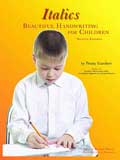This single book teaches both printing and cursive Italic style handwriting. This is similar but not the same as the style taught in the Getty-Dubay Italic Handwriting Series. For example, in Gardner’s Italics the letter “e” is formed with two strokes, then the cursive join comes from the center of the e which is the end point for the second stroke. In the Getty-Dubay series, the cursive “e” is joined in a standard fashion.
Gardner's Italics presents a lovely, but simple italic style that you might introduce either to beginners or to students who have struggled with other styles of handwriting. Rather than having children complete a new workbook each year, Gardner's Italics incorporates copywork. Once children have learned basic letter formation and joins, they need only to practice. Copywork provides that practice along with exposure to lofty thoughts and the beautiful use of language as recommended by Charlotte Mason. There are quite a few copywork models in the book, and there are twelve pages of quotations from famous people that may be used for copywork if you wish.
The—available in print or as a PDF—has many practice worksheets for students to use as they are learning the manuscript and cursive forms and joins. There is space also for students to do some copywork. However, you will probably want to reproduce or print out the lined pages at the back (three different lined-formats from which to choose) for subsequent copy work. Of course, students will eventually reach a point where they will not need custom-lined pages and can use standard paper.
Gardner presents all of this in a 98-page book. I am surprised that the instruction seems quite thorough and detailed for accomplishing so much within one book. However, I did spot one missing explanation that might need clarification. The program teaches an “s” form that looks similar to what you read in this review, yet “s” at the end of a word written in cursive is adapted so that the top curve almost disappears. I can see that it still retains the same directional formation of the letter, but it looks different in the models in the book. Students could complete the top curve or drop it as in the models but you might need to point this out to them.
Students of just about any age can use this program. Beginning instruction does include at least two verses from nursery rhymes, but it quickly moves into excerpts from books such as Charlotte's Web and quotes from people like Tennyson, Lao Tzu, Pearl S. Buck, Abraham Lincoln, and St. Francis of Assisi.
I also appreciate her suggestions for variations to copywork that incorporate grammar skills as well as her recommendation that students learning a foreign language do some copywork in that language.
The printed book is 8.5” x 11” and has a plastic spiral binding so it lies flat. You are given the right to reproduce pages for immediate family members.
Gardner's Italics should work very well alongside just about any curriculum but it is especially appropriate for those adopting a Charlotte Mason approach since it is based upon her recommendations for teaching handwriting.








